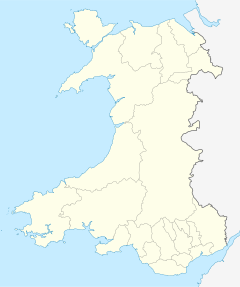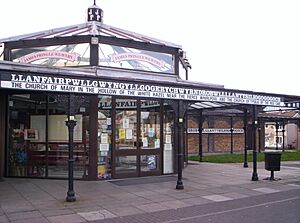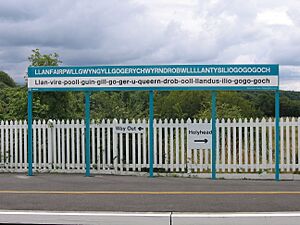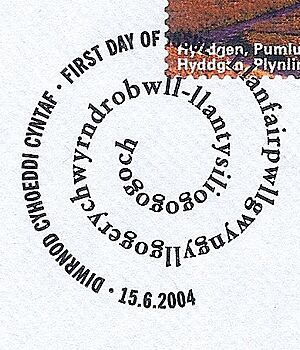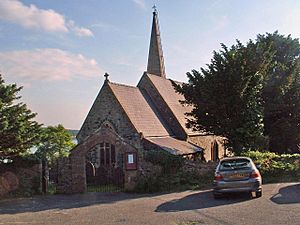Llanfairpwllgwyngyll facts for kids
Quick facts for kids Llanfairpwllgwyngyll |
|
|---|---|
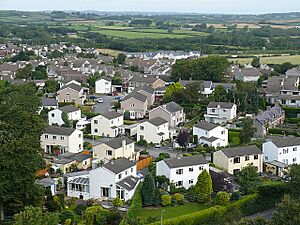 Viewed from the Marquess of Anglesey's Column |
|
| Population | 2,900 (2021 census) |
| OS grid reference | SH528716 |
| Community |
|
| Principal area | |
| Ceremonial county | |
| Country | Wales |
| Sovereign state | United Kingdom |
| Post town | LLANFAIRPWLLGWYNGYLL |
| Postcode district | LL61 |
| Dialling code | 01248 |
| Ambulance | Welsh |
| EU Parliament | Wales |
| UK Parliament |
|
| Welsh Assembly |
|
Llanfairpwllgwyngyll (pronounced: lan-vair-pool-gwin-gil), often called Llanfairpwll or Llanfair PG, is a village in Wales. It is located on the Isle of Anglesey, right next to the Britannia Bridge. In 2021, about 2,900 people lived here. A large number of residents, about 71%, can speak Welsh.
The village is also famous for its very long name: Llanfairpwllgwyngyllgogerychwyrndrobwllllantysiliogogogoch. This name has 58 characters and 18 syllables! It is known as the longest place name in Europe. It is also the second longest one-word place name in the entire world.
Contents
Exploring Llanfairpwll's Past
People have lived in the area of Llanfairpwll for a very long time. Evidence shows human activity since the Neolithic era, which was about 4,000 to 2,000 years BC. Back then, people mostly farmed and fished to survive. Anglesey island could only be reached by boat across the Menai Strait. You can still find remains of ancient burial sites, like a dolmen, from this period. There are also signs of an old hillfort.
Later, the Romans briefly took over the area. They left after a while, and the region became part of the early medieval Kingdom of Gwynedd. A small Christian religious site might have been here since the 7th century. During the medieval period, a church was built and named after Saint Mary. This is why the village name includes "Llanfair," which means "Saint Mary's church" in Welsh.
By 1801, the village had about 385 people. In the 1800s, important bridges were built. The Menai Suspension Bridge connected Anglesey to mainland Wales in 1826. Then, the Britannia Bridge and a busy railway line arrived in 1850. This connected the village to London and the ferry port of Holyhead. The old part of the village, called Pentre Uchaf (upper village), was joined by a new area around the railway station, known as Pentre Isaf (lower village).
In 1915, the first meeting of the Women's Institute in Britain happened in Llanfairpwll. This group, which started in Canada, then spread across the British Isles.
Understanding the Village Name
The original name of the area was Pwllgwyngyll. This means "the pool of the white hazels." The full parish name, Llanfair y Pwllgwyngyll, meaning "Saint Mary's church of the pool of the white hazels," was used by the mid-1500s. Adding the hazel pool part helped tell it apart from other places in Wales also named Llanfair.
The very long version of the name was created in the 1800s. People believe it was a clever way to attract tourists and businesses to the village. It made the railway station famous for having the longest name in Britain. The long name is 58 characters long, making it one of the longest in the world.
How the Long Name Was Created
The long name was supposedly made up in 1869. It was an early publicity stunt to give the railway station the longest name in Britain. A local tailor is said to have created it.
The long name adds more details about the area:
- It mentions a whirlpool in the Menai Strait called the Swellies.
- It includes a small chapel on a nearby island, dedicated to Saint Tysilio.
- The last part, -gogogoch, means "red cave."
So, the full name literally means: "The church of Saint Mary of the pool of the white hazels near to the fierce whirlpool and the church of Saint Tysilio of the red cave."
Things to See and Do
Llanfairpwll welcomes about 200,000 visitors each year. The most popular spot is the Llanfairpwll railway station. Here, you can see the famous sign with the village's full, very long name.
Other interesting places to visit nearby include:
- Anglesey Sea Zoo: A great place to learn about sea creatures.
- Bryn Celli Ddu Burial Chamber: An ancient tomb from the Stone Age.
- St. Tysilio's Church: A historic church on an island.
- Plas Cadnant Hidden Gardens: Beautiful gardens to explore.
Llanfairpwll in Science
In 2020, scientists discovered a new type of bacteria in the soil of the village. They named this tiny organism Myxococcus llanfairpwllgwyngyllgogerychwyrndrobwllllantysiliogogogochensis. Its name is just as long as the village!
Weather in Llanfairpwll
The village has a mild oceanic climate. This means it has mild summers and cool, wet winters.
| Climate data for Llanfairpwllgwyngyll, 1961–1990, Altitude: 15 metres above mean sea level | |||||||||||||
|---|---|---|---|---|---|---|---|---|---|---|---|---|---|
| Month | Jan | Feb | Mar | Apr | May | Jun | Jul | Aug | Sep | Oct | Nov | Dec | Year |
| Record high °C (°F) | 16 (61) |
17 (63) |
22 (72) |
24 (75) |
28 (82) |
29 (84) |
31 (88) |
34 (93) |
27 (81) |
25 (77) |
18 (64) |
17 (63) |
34 (93) |
| Mean daily maximum °C (°F) | 7.7 (45.9) |
8.0 (46.4) |
9.7 (49.5) |
12.1 (53.8) |
15.2 (59.4) |
17.9 (64.2) |
19.4 (66.9) |
19.3 (66.7) |
17.4 (63.3) |
14.6 (58.3) |
10.5 (50.9) |
8.7 (47.7) |
13.4 (56.1) |
| Daily mean °C (°F) | 5.2 (41.4) |
5.1 (41.2) |
6.6 (43.9) |
8.5 (47.3) |
11.3 (52.3) |
14.0 (57.2) |
15.7 (60.3) |
15.6 (60.1) |
13.9 (57.0) |
11.5 (52.7) |
7.8 (46.0) |
6.1 (43.0) |
10.1 (50.2) |
| Mean daily minimum °C (°F) | 2.6 (36.7) |
2.2 (36.0) |
3.4 (38.1) |
4.9 (40.8) |
7.4 (45.3) |
10.1 (50.2) |
11.9 (53.4) |
11.9 (53.4) |
10.4 (50.7) |
8.3 (46.9) |
5.0 (41.0) |
3.5 (38.3) |
6.8 (44.2) |
| Record low °C (°F) | −9 (16) |
−8 (18) |
−7 (19) |
−3 (27) |
−1 (30) |
2 (36) |
5 (41) |
4 (39) |
1 (34) |
−1 (30) |
−4 (25) |
−8 (18) |
−9 (16) |
| Average rainfall mm (inches) | 107 (4.2) |
72 (2.8) |
85 (3.3) |
65 (2.6) |
65 (2.6) |
68 (2.7) |
74 (2.9) |
95 (3.7) |
98 (3.9) |
120 (4.7) |
130 (5.1) |
123 (4.8) |
1,102 (43.3) |
| Average rainy days (≥ 0.2 mm) | 19.7 | 15.0 | 18.9 | 14.1 | 18.9 | 13.7 | 13.1 | 15.1 | 15.8 | 18.7 | 19.5 | 19.5 | 202 |
| Average snowy days | 2.9 | 3.1 | 1.7 | 0.7 | 0.1 | 0.0 | 0.0 | 0.0 | 0.0 | 0.0 | 0.4 | 1.6 | 10.5 |
| Mean monthly sunshine hours | 49.6 | 73.5 | 105.4 | 153.0 | 195.3 | 183.0 | 173.6 | 164.3 | 126.0 | 93.0 | 57.0 | 40.3 | 1,414 |
| Source: Met Office | |||||||||||||
| Climate data for Llanfairpwllgwyngyll, 1961–1990, Altitude: 15 metres above mean sea level | |||||||||||||
|---|---|---|---|---|---|---|---|---|---|---|---|---|---|
| Month | Jan | Feb | Mar | Apr | May | Jun | Jul | Aug | Sep | Oct | Nov | Dec | Year |
| Average rainy days (≥ 1.0 mm) | 15.6 | 11.2 | 13.0 | 10.4 | 10.9 | 10.3 | 9.4 | 11.7 | 12.3 | 15.0 | 15.7 | 15.1 | 150.6 |
| Source: Met Office | |||||||||||||
| Climate data for Llanfairpwllgwyngyll, 1961–1990, Altitude: 15 metres above mean sea level | |||||||||||||
|---|---|---|---|---|---|---|---|---|---|---|---|---|---|
| Month | Jan | Feb | Mar | Apr | May | Jun | Jul | Aug | Sep | Oct | Nov | Dec | Year |
| Average rainy days (≥ 10.0 mm) | 2.5 | 1.7 | 2.0 | 1.5 | 1.2 | 1.6 | 2.2 | 2.7 | 2.8 | 3.4 | 3.8 | 3.5 | 28.9 |
| Source: Met Office | |||||||||||||
Famous People from Llanfairpwll
Many interesting people have connections to Llanfairpwll:
- Wilfred Mitford Davies (1895–1966): A Welsh artist and publisher who went to school in the town.
- Sir John "Kyffin" Williams (1918–2006): A famous Welsh landscape painter who lived nearby.
- Naomi Watts (born 1968): An English actress and film producer who lived in the town as a child.
- Taron Egerton (born 1989): A Welsh actor who went to school in the town.
- Elin Fflur (born 1984): A Welsh singer-songwriter and TV/radio presenter.
See also
 In Spanish: Llanfairpwllgwyngyll para niños
In Spanish: Llanfairpwllgwyngyll para niños


